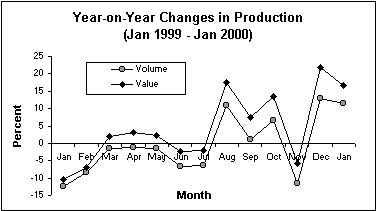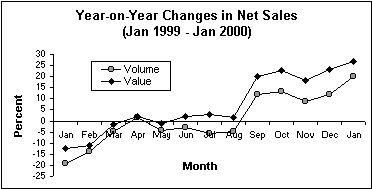- Production Up in January 2000
The value and volume of production in manufacturing for January 2000 registered year-on-year growths of 16.7 percent and 11.6 percent, respectively according to the preliminary results of the Monthly Integrated Survey of Selected Industries (MISSI).
Petroleum refineries posted the highest growth in value of production while textile had the highest growth in volume of production.
- Net Sales Post Growths in January 2000
January 2000 net sales in manufacturing recorded 26.8 percent and 20.0 percent year-on-year growths in the value and volume of net sales, respectively. Tobacco had the highest growths in both value and volume of net sales, posting 117.1 percent and 117.4 percent, respectively.
- Average Capacity Utilization at 81.1%
Average capacity utilization for January 2000 for manufacturing was estimated at 81.1 percent, up by 0.8 percentage point from 80.3 percent last year. Ten out of 16 sectors showed improvements in their capacity utilization rate as compared to the same month last year. Electrical machinery had the highest capacity utilization rate while wood and wood products posted the lowest capacity utilization rate.
Value of Production
In January 2000, the value of production index (VaPI) of 486.6 increased by 16.7 percent from 417.0 in January 1999. Year-on year increases were observed in 9 out 16 major sectors (See Annex 1-A). Increases were observed in the following sectors: petroleum refineries (55.9%), furniture & fixtures (41.1%), beverage (32.6%), electrical machinery (30.1%), rubber products (16.6%), other manufacturing industries (15.8%), textile (14.6%), transport equipment (12.3%) and non-metallic mineral products (9.5%).
On the other hand, sectors that decreased were basic metals (-31.1%), paper & paper products (-23.4%), tobacco (-17.3%), wood & wood products (-15.7%), wearing apparel (-6.9%), chemicals (-4.2%) and food manufacturing (-3.0%).

Volume of Production
The volume of production index (VoPI) for total manufacturing grew by 11.6 percent to 136.1 from 122.0 of the same month last year. Nine out of 16 sectors posted year-on-year increases led by textile with 51.5 percent (See Annex 1-B). Other sectors which contributed to the positive performance were furniture & fixtures (41.1%), other manufacturing industries (35.3%), beverage (29.5%), electrical machinery (28.0%), petroleum refineries (17.0%), rubber products (15.7%), transport equipment (8.9%) and food manufacturing (5.1%). The improvements in these sectors can be attributed to the increased demand of these products for the local and export markets.
On the other hand, dips in the following sectors were noted: basic metals (-39.5%), paper & paper products (-24.6%), tobacco (-17.2%), wood & wood products (-15.7%), wearing apparel (-14.5%), non-metallic mineral products (-13.1%), and chemicals/plastic & plastic products (-8.9%). Production in these sectors slowed down due to the following factors solely or jointly: low demand for these products, higher cost of raw materials, lack of raw materials, and partial shutdown of some plants due to machine breakdown and some labor problems.
Value of Net Sales
The value of net sales for January 2000 increased by 26.8 percent compared to the same month last year. Thirteen out of 16 major sectors showed improvements in their value of net sales. Leading sector was tobacco posting 117.1 percent growth over the same month last year (See Annex 2-A). Other sectors that recorded double-digit increases were basic metals (77.1%), petroleum products (70.6%), paper & paper products (57.7%), non-metallic mineral products (55.4%), furniture & fixtures (36.5%), beverage (26.5%), electrical machinery (24.5%), miscellaneous manufactures (18.7%) and chemicals (13.7%).
On the other hand, transport equipment had the biggest decline of 58.6 percent. Other sectors with lower values of net sales were rubber products (-36.6%), and wood & wood products (-30.5%).

Volume of Net Sales
The volume of net sales for January 2000 increased by 20.0 percent over the same month last year. Increases were observed in 12 out of 16 sectors led by tobacco which increased by 117.4 percent (See Annex 2-B). Other sectors that exhibited double-digit increases were basic metals (71.3%), paper & paper products (55.1%), non-metallic mineral products (54.9%), miscellaneous manufactures (38.7%), furniture & fixtures (36.5%), textile products (35.1%), petroleum products (28.0%), beverage (23.6%), electrical machinery (22.4%) and food manufacturing (17.5%).
On the other hand, decreases were observed in 4 out of 16 sectors led by transport equipment which decreased by 59.8 percent. Other sectors that declined were rubber products (-37.1%), wood & wood products (-30.5%) and wearing apparel (-5.7%).
Capacity Utilization
The proportion of responding establishments that operated below 70 percent capacity was 38.8 percent in January 2000, which was slightly lower by 1.1 percentage points to the 39.9 percent in January 1999. Also, about 18.1 percent operated at full capacity (90%-100%) compared to 16.8 percent a year ago.
The January 2000 average capacity utilization rate for manufacturing was estimated at 81.1 percent, which was 0.8 percentage point higher than the 80.3 percent posted last year (See Annex 3A). Of the 16 major sectors, ten sectors posted higher capacity utilization rates as compared to a year ago. Electrical machinery had the highest capacity utilization rate at 94.1 percent. Other sectors with more than 80 percent capacity utilization were wearing apparel (83.6%), furniture & fixtures (86.6%), rubber products (85.4%), petroleum products (85.9%), non-metallic mineral (82.7%), transport equipment (80.9%) and miscellaneous manufactures (85.2%).
Response Rate
These results were based on the response of 309 sample establishments, which comprised 59.3 percent of the total number of establishments covered by the survey.






Percentage Changes in Production and Net Sales of
Key Enterprises: January 1999 - January 2000
|
|
|||||||||||||
| ITEM | 1999 | 2000 | |||||||||||
| JAN | FEB | MAR | APR | MAY | JUN | JUL | AUG | SEP | OCT | NOV | DEC | JAN | |
|
|
|||||||||||||
| Year-on-Year Change Production Value Volume Net Sales Value Volume |
-10.4r -12.2 |
-7.0r -11.1 |
1.9r -1.7 |
3.0r 2.1 |
2.3r -1.3 |
-2.3r 2.0 |
-2.0r 3.1 |
17.4r 1.4 |
7.4r 20.1 |
13.5r 22.9 |
-5.8r 18.2 |
21.8r 23.4 |
16.7 26.8 |
| Month-on-Month Change Production Value Volume Net Sales Value Volume |
-2.4r -2.7 |
8.0r 31.3 |
11.0r 8.0 |
-11.0r -6.6 |
4.4r 7.0 |
4.8r 3.7 |
-3.2r 2.5 |
15.3r -2.8 |
-3.6r 12.6 |
0.5r 1.6 |
-19.0 -2.9 |
22.1r 3.9 |
-6.5 -3.5 |
|
r - revised due to updating of data from late responding establishments. |
|||||||||||||
Source: National Statistics Office
Manila, Philippines
